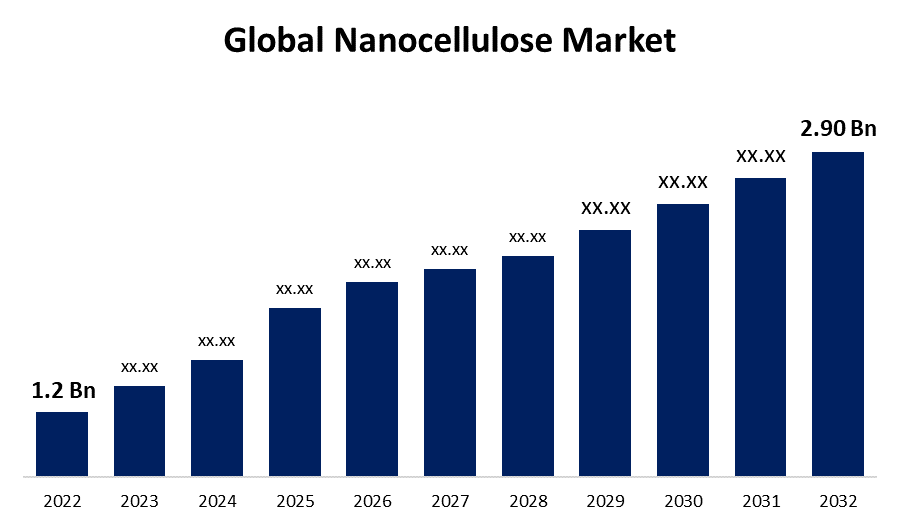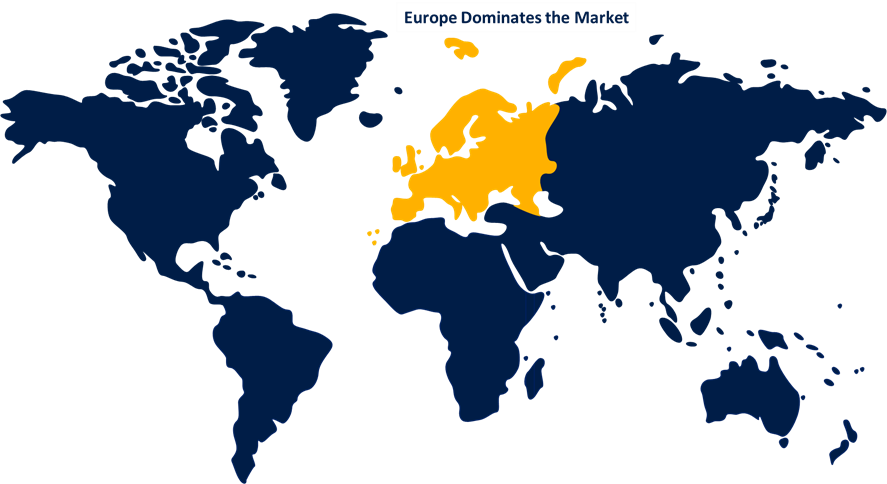Global Nanocellulose Market Size To Worth USD 2.90 Billion by 2032 | CAGR of 25.6%.
Category: Chemicals & MaterialsGlobal Nanocellulose Market Size To Worth USD 2.90 Billion by 2032
According to a research report published by Spherical Insights & Consulting, the Global Nanocellulose Market Size To Grow from USD 1.2 Billion in 2022 to USD 2.90 Billion by 2032, at a Compound Annual Growth Rate (CAGR) of 25.6% during the forecast period.

Get more details on this report -
Browse key industry insights spread across 200 pages with 110 Market data tables and figures & charts from the report on "Global Nanocellulose Market Size, Share, and COVID-19 Impact By Type (Cellulose Nanofibers, Bacterial Cellulose, Crystalline Nanocellulose), By Application (Pulp & Paper, Composites Manufacturing, Paints & Coatings, Electronics Sensors, Food and Beverage, Biomedical & Pharmaceuticals, Composites, Others), by Region (North America, Europe, Asia-Pacific, Latin America, Middle East, and Africa), Analysis and Forecast 2022 – 2032." Get Detailed Report Description Here: https://www.sphericalinsights.com/reports/nanocellulose-market
Nanocellulose is a type of cellulose made up of nanometer-sized cellulose fibers or particles. Cellulose is the most common organic molecule on Earth and is the main structural component of plant cell walls. Nanocellulose can be produced from a variety of sources, including wood pulp, agricultural waste, and particular kinds of bacteria. Nanocellulose stands out from other materials thanks to its unique properties, which include a sizable surface area, a high aspect ratio, and mechanical strength. These characteristics make nanocellulose an intriguing and versatile material with a wide range of potential applications in different industries. Industry applications for nanocellulose include biodegradable materials, composites, filtration membranes, pharmaceuticals, electronics, and food products, to name just a few.
COVID 19 Impact
Global supply networks were disrupted by the pandemic, which had an effect on the manufacturing and distribution of nanocellulose products. Travel restrictions, lockdowns, and temporary closures of manufacturing facilities may have contributed to delays in the supply of raw materials and final items. Demand for several industries that employ nanocellulose products, such as packaging, textiles, and construction, declined as a result of economic instability and lower consumer spending during lockdowns and restrictions. The demand for products created using nanocellulose may have been impacted. The market for nanocellulose in multiple application sectors may have been impacted by the pandemic's effects on various enterprises.
As concerns about environmental sustainability grew, industries all over the world began looking for eco-friendly substitutes for traditional materials. Nanocellulose is used more and more frequently in a wide range of applications due to its biodegradability and reliance on renewable resources. Nanocellulose is used in a variety of products and sectors, including packaging, composites, electronics, food, and biological ones. As fresh and innovative uses were discovered, the market for nanocellulose expanded. The general public's understanding of environmentally friendly items and their consequences was growing. Due to the shift in consumer tastes, companies were forced to utilize more environmentally friendly alternatives like nanocellulose.
One of the biggest challenges the nanocellulose sector has is the cost of manufacture. The extraction and purification of nanocellulose from raw materials like wood pulp or agricultural waste may consume resources and time. Cutting production costs is necessary to make nanocellulose more commercially feasible and competitive with other materials. Even though nanocellulose may be produced on a limited scale in research facilities, expanding production to meet market demands is still challenging. To accomplish reliable, large-scale production while maintaining the necessary properties of nanocellulose, it is a difficult endeavor that necessitates further research and investment. Even though nanocellulose has applications across a wide range of industries, some have made more progress than others in commercializing it.
Type Insights
The cellulose Nanofibers segment is dominating the market over the forecast period
On the basis of type, the global nanocellulose market is segmented into Cellulose Nanofibers, Bacterial Cellulose, Crystalline Nanocellulose. Among these, cellulose nanofibers segment is dominating the market over the forecast period. CNFs are stiff, have high mechanical properties, and a favorable aspect ratio. They are desirable as reinforcement for composite materials like polymers or cement because of their properties, which enhance mechanical performance. CNFs are created from renewable resources, such as wood pulp and agricultural waste, and they are biodegradable, making them suitable for applications needing sustainable materials. Cellulose nanofibers are used in a wide range of industries, including packaging, paper, textiles, electronics, pharmaceuticals, and more. Because of their versatility and adjustability, they are great for a range of end uses.
Application Insights
Pulp and paperboard application segment holds the highest market share over the forecast period
Based on the application, the global nanocellulose market is segmented into Pulp & Paper, Composites Manufacturing, Paints & Coatings, Electronics Sensors, Food and Beverage, Biomedical & Pharmaceuticals, Composites, Others. Among these, pulp and paperboard application segment holds the highest market share over the forecast period. Two of the many mechanical characteristics that set nanocellulose, particularly CNFs, apart are its high tensile strength and stiffness. In order to create stronger and more durable materials, nanocellulose can enhance the mechanical performance of pulp and paperboard products. Nanocellulose can be used to make pulp and paperboard products lighter while maintaining their strength and functionality. By reducing the amount of material used and the cost of transportation, this lightweighting effect can contribute to sustainability goals.
Regional Insights
Europe is dominating the market with the largest market share over the forecast period

Get more details on this report -
Among all other regions, Europe is dominating the market with the largest market share over the forecast period. Nanocellulose technology and applications are currently being developed by a large number of academic institutions, research facilities, and enterprises, positioning Europe at the forefront of the field. In Europe, stewardship of the environment and sustainability are highly prized. Since it is a renewable and biodegradable material that aligns well with the region's sustainability goals, nanocellulose is becoming more and more popular as a green alternative to conventional materials. With products used in packaging, textiles, paper, composites, electronics, and biomedical devices among other industries, the European nanocellulose industry is large.
Asia Pacific is witnessing the fastest market growth over the forecast period. In the Asia-Pacific region, nanocellulose is being utilized more frequently in a number of industries, including packaging, textiles, electronics, automotive, construction, and biomedicine. Numerous sectors are interested in nanocellulose due to its versatility and ability to enhance the quality of materials. The acceptance of sustainability and the hunt for more ecologically friendly business practices and products have increased throughout the Asia-Pacific region. Nanocellulose is environmentally friendly, renewable, and biodegradable, which makes it a good fit for these sustainability objectives.
Market Segment
This study forecasts revenue at global, regional, and country levels from 2019 to 2032. Spherical Insights has segmented the global Nanocellulose Market based on the below-mentioned segments:
Nanocellulose Market, Type Analysis
- Cellulose Nanofibers
- Bacterial Cellulose
- Crystalline Nanocellulose
Nanocellulose Market, Application Analysis
- Pulp & Paper
- Composites Manufacturing
- Paints & Coatings
- Electronics Sensors
- Food and Beverage
- Biomedical & Pharmaceuticals
- Composites
- Others
Nanocellulose Market, Regional Analysis
- North America
- US
- Canada
- Mexico
- Europe
- Germany
- Uk
- France
- Italy
- Spain
- Russia
- Rest of Europe
- Asia Pacific
- China
- Japan
- India
- South Korea
- Australia
- Rest of Asia Pacific
- South America
- Brazil
- Argentina
- Rest of South America
- Middle East & Africa
- UAE
- Saudi Arabia
- Qatar
- South Africa
- Rest of Middle East & Africa
About the Spherical Insights & Consulting
Spherical Insights & Consulting is a market research and consulting firm which provides actionable market research study, quantitative forecasting and trends analysis provides forward-looking insight especially designed for decision makers and aids ROI.
Which is catering to different industry such as financial sectors, industrial sectors, government organizations, universities, non-profits and corporations. The company's mission is to work with businesses to achieve business objectives and maintain strategic improvements.
CONTACT US:
For More Information on Your Target Market, Please Contact Us Below:
Phone: +1 303 800 4326 (the U.S.)
Phone: +91 90289 24100 (APAC)
Email: inquiry@sphericalinsights.com, sales@sphericalinsights.com
Contact Us: https://www.sphericalinsights.com/contact-us
Need help to buy this report?